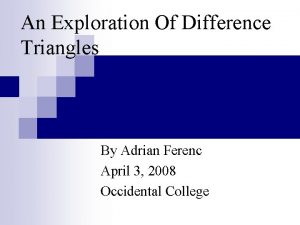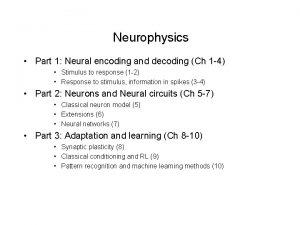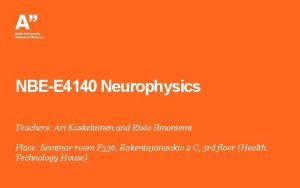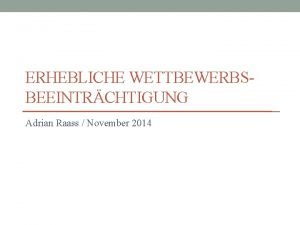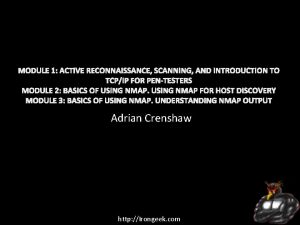Neurophysics part 2 Adrian Negrean adrian negreancncr vu














- Slides: 14

Neurophysics - part 2 - Adrian Negrean adrian. negrean@cncr. vu. nl

Contents 1. Aim of this class 2. A first order approximation of neuronal biophysics 1. Introduction 2. Electro-chemical properties of neurons 3. Ion channels and the Action Potential 4. The Hodgkin-Huxley model 5. The Cable equation 6. Multi-compartmental models

The Cable equation • Describes the propagation of signals in electrical cables, and in this case it will be applied to dendrites and axons Case study: Simultaneous intracellular recordings from soma and dendrite A) An action potential is produced in the soma B) A set of axon fibers is stimulated to produce a compound excitatory postsynaptic potential What are the differences and how do you explain them ?

• The longitudinal resistance of an axon or dendrite is: with r. L - intracellular resistivity ( m) Δx - segment length a - segment radius • The intracellular resistivity depends on the ionic composition of the intracellular milieu (and on the distribution of organelles)

• The longitudinal current through such a segment is: where ΔV(x, t) is the voltage gradient across the segment • Currents flowing in the increasing direction of x are defined to be positive

• In the limit : • Besides the longitudinal currents, there are several membrane currents flowing in/out of the segment: do you understand the formula ?

• Applying the principle of charge conservation for the previous cable segment we get: • Divide the above by such that the r. h. s. is in the limit

• Under the assumption that r. L does not vary with position the cable equation is obtained: • The radius of the cable is allowed to vary to simulate the tapering of dendrites • Boundary conditions required for V(x, t) and • Linear cable approximation: Ohmic membrane current im

• Use change of variables • And multiply by rm to get: with membrane time constant and electrotonic length (in the linear cable approximation)

• Steady state (A) and transient (B) solutions to the linear cable equation:

Multi-compartmental models • To calculate the membrane potential dynamics of a neuron, the cable equation has to be discretized and solved numerically

• The membrane potential dynamics of a single isolated compartment is described by: injected current through electrode specific membrane capacitance (Fm 2) surface area of compartment membrane currents due to ion-channels / membrane area • Several compartments coupled in a non-branching manner:

• The Ohmic coupling constants between two compartments with same length and radii:

• Next time you see a neuron, you should see this:
 Adrian negrean
Adrian negrean Adrian negrean
Adrian negrean The centerpiece of any pouring station.
The centerpiece of any pouring station. Part to part ratio definition
Part to part ratio definition The part of a shadow surrounding the darkest part
The part of a shadow surrounding the darkest part Brainpop ratios
Brainpop ratios Minitab adalah
Minitab adalah Technical description examples
Technical description examples Part part whole addition
Part part whole addition Adrian holliday small cultures
Adrian holliday small cultures Private first class richard reiben
Private first class richard reiben Adrian paschke
Adrian paschke Ignatius adrian mastan
Ignatius adrian mastan Adrian ferenc
Adrian ferenc Victor prez
Victor prez













